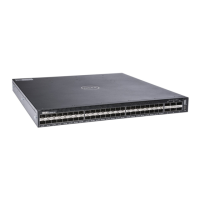no area area-id authentication ipsec spi number
• Display the configuration of IPSec authentication policies on the router.
show crypto ipsec policy
Configuring IPsec Encryption for an OSPFv3 Area
To configure, remove, or display IPsec encryption in an OSPFv3 area, use the following commands.
Prerequisite: Before you enable IPsec encryption in an OSPFv3 area, first enable OSPFv3 globally on the
router (refer to
Configuration Task List for OSPFv3 (OSPF for IPv6)).
The SPI value must be unique to one IPsec security policy (authentication or encryption) on the router.
Configure the same encryption policy (the same SPI and keys) on each interface in an OPSFv3 link.
NOTE: When you configure encryption using the area encryption command, you enable both IPsec
encryption and authentication. However, when you enable authentication on an area using the area
authentication
command, you do not enable encryption at the same time.
If you have enabled IPsec authentication in an OSPFv3 area using the area authentication command,
you cannot use the area encryption command in the area at the same time.
The configuration of IPsec encryption on an interface-level takes precedence over an area-level
configuration. If you remove an interface configuration, an area encryption policy that has been configured is
applied to the interface.
• Enable IPsec encryption for OSPFv3 packets in an area.
CONF-IPV6-ROUTER-OSPF mode
area area-id encryption ipsec spi number esp encryption-algorithm [key-
encryption-type] key authentication-algorithm [key-authentication-type] key
• area area-id: specifies the area for which OSPFv3 traffic is to be encrypted. For area-id, enter a
number or an IPv6 prefix.
• spi number: is the security policy index (SPI) value. The range is from 256 to 4294967295.
• esp encryption-algorithm: specifies the encryption algorithm used with ESP. The valid values
are 3DES, DES, AES-CBC, and NULL. For AES-CBC, only the AES-128 and AES-192 ciphers are
supported.
• key: specifies the text string used in the encryption. All neighboring OSPFv3 routers must share the
same key to decrypt information. The required lengths of a non-encrypted or encrypted key are:
3DES - 48 or 96 hex digits; DES - 16 or 32 hex digits; AES-CBC - 32 or 64 hex digits for AES-128 and
48 or 96 hex digits for AES-192.
• key-encryption-type: (optional) specifies if the key is encrypted. Valid values: 0 (key is not
encrypted) or 7 (key is encrypted).
• authentication-algorithm: specifies the authentication algorithm to use for encryption. The
valid values are MD5 or SHA1.
• key: specifies the text string used in authentication. All neighboring OSPFv3 routers must share key
to exchange information. For MD5 authentication, the key must be 32 hex digits (non-encrypted) or
64 hex digits (encrypted). For
SHA-1 authentication, the key must be 40 hex digits (non-encrypted)
or 80 hex digits (encrypted).
• key-authentication-type: (optional) specifies if the authentication key is encrypted. The valid
values are 0 or 7.
• Remove an IPsec encryption policy from an OSPFv3 area.
no area area-id encryption ipsec spi number
Open Shortest Path First (OSPFv2 and OSPFv3) 762

